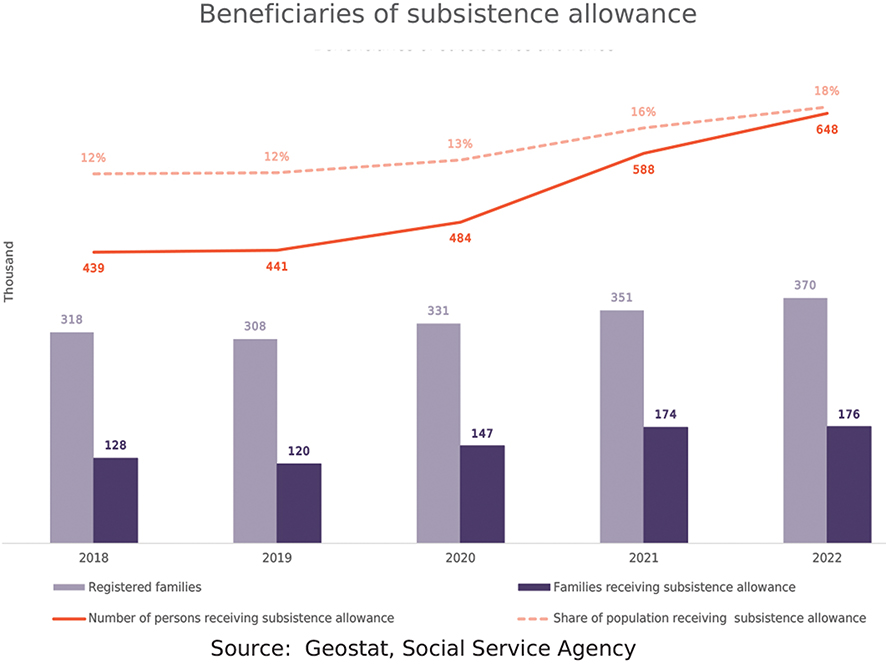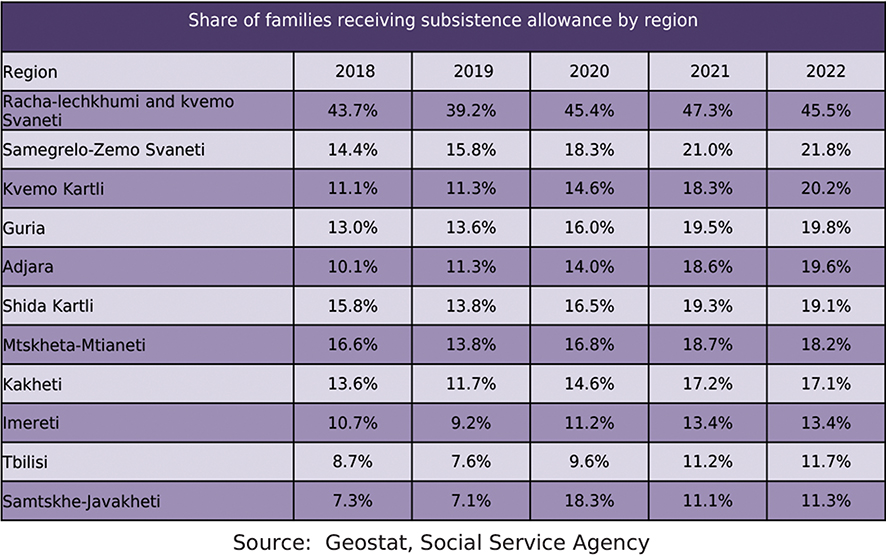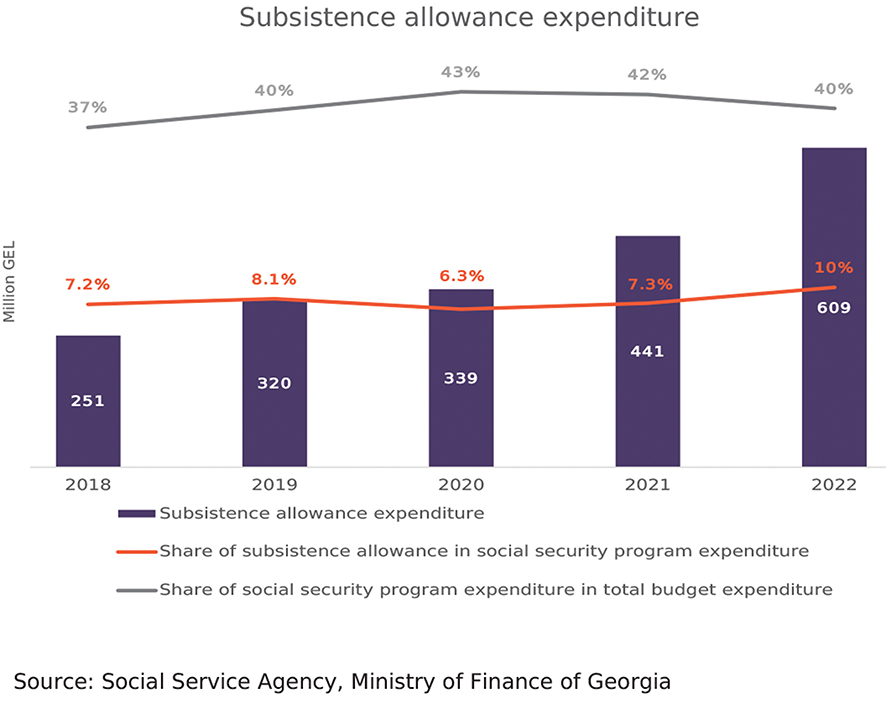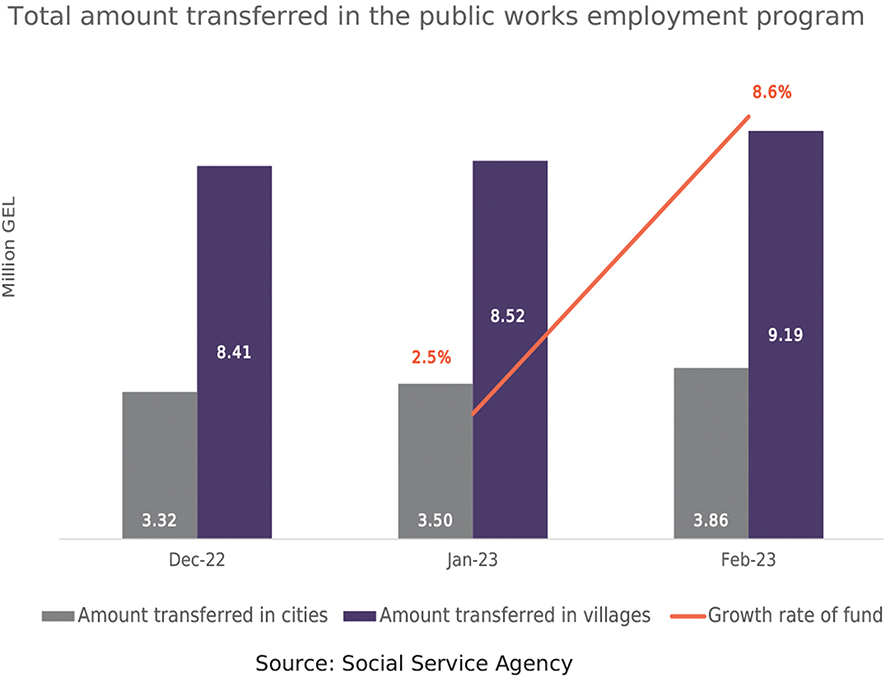Socio-economic problems continue to represent a significant challenge for Georgia. Specifically, in 2021, 17.5% of the Georgian population fell under the absolute poverty line1. By and large, different states typically offer various forms of social assistance (including subsistence allowance) to help the most vulnerable within society. In Georgia, the subsistence allowance program provides financial aid to the country’s poorest families, whose rating score is less than 120,001. The rating score is determined by the social services agency and reflects the family’s income and assets. The lower the score, the poorer the family2. However, recent studies3 have indicated that this program does not help beneficiaries to get out of poverty and that it instead encourages them to maintain a low income to remain eligible to receive the allowance. To address such issues, starting from March 2022, the Georgian government implemented a wide-scale public works employment program for the country’s socially vulnerable citizens4. It should be noted that the persons involved in the program will maintain the status of socially vulnerable for 4 years. In this newsletter, we take a close look at the dynamics of the population receiving subsistence allowance. Moreover, the trends with respect to the announced working program are also discussed.

Beneficiaries of subsistence allowance
Every family in Georgia can register on the Social Service Agency’s platform and request the subsistence allowance. Overall, the number of registered families and families receiving subsistence allowance decreased between 2018 and 2019 (the number of registered families dropped from 318 thousand to 308 thousand and the number of families receiving subsistence allowance went from 128 thousand to 120 thousand).
However, from 2019 to 2022, the number of registered families increased by 20% and reached 370 thousand, while the number of families receiving the subsistence allowance increased by 47% over the same period, amounting to 176 thousand. It should be noted that over the analyzed period, on average per year, 44% of registered families received subsistence allowance. Meanwhile, the number of persons receiving subsistence allowance increased markedly between 2018 and 2022, rising from 439 thousand to 648 thousand, equating to 48% growth. Over the same period (2018-2022), the share of the population receiving the subsistence allowance also rose, from 12% to 18%.
The increase in the number of beneficiaries receiving the subsistence allowance since 2020 can be largely attributed to the addition of a new score category (100001-120000) to the Agency’s rating. Furthermore, the increases in 2020 and 2021 were of course also influenced by the COVID-19 pandemic.

Share of families receiving subsistence allowance by region
To gain a broader picture of subsistence allowance beneficiaries, it is important to break down the dynamics of families receiving it at regional level. From 2018 to 2019, with the exception of the regions of Adjara, Guria, Samegrelo-Zemo Svaneti, and Kvemo Kartli, the share of families receiving subsistence allowance decreased. However, from 2019 to 2022, the share of families receiving the subsistence allowance increased in every region. The sharpest increase was recorded in Adjara (8.3 percentage points), and the least significant was in Tbilisi (4.1 percentage points).
Overall, in the analyzed period, on average the highest shares of families receiving the subsistence allowance were recorded in Racha-Lechkhumi and Kvemo Svaneti (44.2%), Samegrelo-Zemo Svaneti (18.3%), and Shida Kartli (16.9%). Meanwhile, the lowest shares were recorded in Tbilisi (9.8%), Samtskhe-Javakheti (11%), and Imereti (11.6%).

Subsistence allowance expenditures
Over the last five years, budget expenditure on social security programs has gradually increased (from GEL 3.3 billion to GEL 6 billion). As a result, the share of social security program expenditure in total budget expenditure also increased from 37% to 40% over the analyzed period.
Correlating with the increase in social security program expenditure, the subsistence allowance expenditure also increased. During the analyzed period, subsistence allowance expenditure rose markedly from GEL 251 million to GEL 609 million, indicating an average annual growth rate of 20%. It is worth noting that over the analyzed period, the lowest number of subsistence allowance beneficiaries was recorded in 2019. However, compared to 2018, expenditure increased by 27% in 2019. This increase was determined by the overall growth of the subsistence allowance financial package.
Over the analyzed period, the share of subsistence allowance in social security programs fluctuated from 7.2% to 10%.

Average amount of monthly subsistence allowance and subsistence minimum
As mentioned above, the subsistence allowance is intended to protect the most vulnerable parts of society and to provide essential financial assistance so that their basic needs can be met.
Here, it is worthwhile to compare the average subsistence allowance amount per family to the average subsistence minimum for a family. The latter represents the amount of money that a family needs to meet its basic needs in Georgia.
From 2018 to 2022, the average monthly subsistence allowance per family increased from GEL 163 to GEL 256, and the subsistence minimum for a family increased from GEL 292 to GEL 314.
A comparison of these indicators over the analyzed period reveals that the average monthly subsistence minimum was on average 51% higher than the average monthly subsistence allowance.

The number of families/individuals involved in the public works employment program
In this bulletin, we also review the public works employment program introduced by the government5. The percentage of people who were participating in the program in December 2022 was equivalent to 25% of those receiving subsistence allowance, and it rose to 29% in February 2023, while the number of families engaged in the program increased from 20% to 23%.
From December 2022 to February 2023, the monthly number of individuals in the public works employment program averaged at 142 thousand, and reached its peak in February. In the same period, the number of families involved in the program hit a monthly average of 31 thousand.
Throughout the analyzed three months, the majority of pulic works employment program participants were from Samegrelo-Zemo Svaneti region, with 18% of individuals and 19% of families. In contrast, Racha-Lechkhumi and Kvemo Svaneti region had the lowest number of recipients, which can be explained by the low population density in this region.

Total amount transferred in the public works employment program
The public works employment program has seen a sustained increase in the amount of funds allocated to individuals and families guaranteed to maintain “socially vulnerable” status for the next four years. During the observed three months, total funds amounted to GEL 37 million. Specifically, one trend observed over the course of the three months was that the program’s budgetary allotment grew by 2.5% from December to January, reaching a total of GEL 12 million, and subsequently increased by 8.6% from January to February, amounting to a total of GEL 13 million.
The amount of funds transferred to socially vulnerable individuals and families was notably higher in rural areas compared to urban areas. As mentioned above, in February 2023, the highest number of program participants was found in the Samegrelo-Zemo Svaneti region, where the amount of funding was proportional to the percentage of families enrolled in the program, at 19%, and indicating 8% increase compared to January. This was followed by Imereti region (17%) and Tbilisi (12%).
Overall, over the last five years, the number of beneficiaries receiving the subsistence allowance has notably increased. Along with the rise in the number of beneficiaries, the budget expenditures to finance the program has grown. The increase in the costs of the program, along with the increase in the number of beneficiaries, also was caused by a rise in the average subsistence allowance per family since 2019.
However, the average amount of allowance per family remains lower than the subsistence minimum for the average family. Moreover, the public works employment program’s dynamics illustrate that, overall, participation is very low, albeit increasing gradually
Footnotes:
1. https://www.geostat.ge/ka/modules/categories/192/tskhovrebis-done
2. https://ssa.moh.gov.ge/main.php?lang=1&id=202212140245508581419937
3. https://www.unicef.org/georgia/media/1216/file/Mapping.pdf
4. https://www.moh.gov.ge/ka/757/. Participants in this program must be at least 18 years old, residents of Georgia, receiving targeted social assistance from the government, and have a family rating score of no more than 120,000.
5. Because the Social Service Agency only disclosed statistics on the program from December 2022 to February 2023, only this period is examined in the publication
![]()














